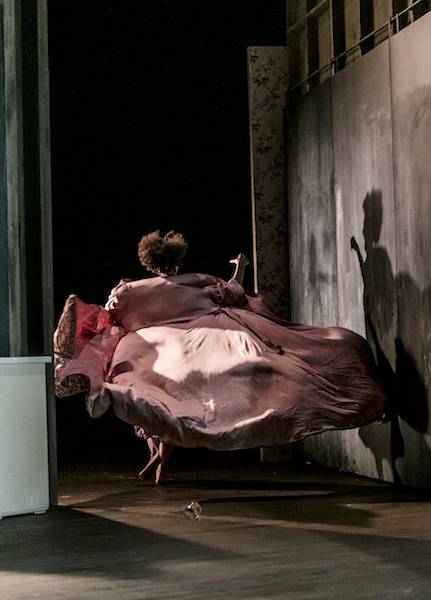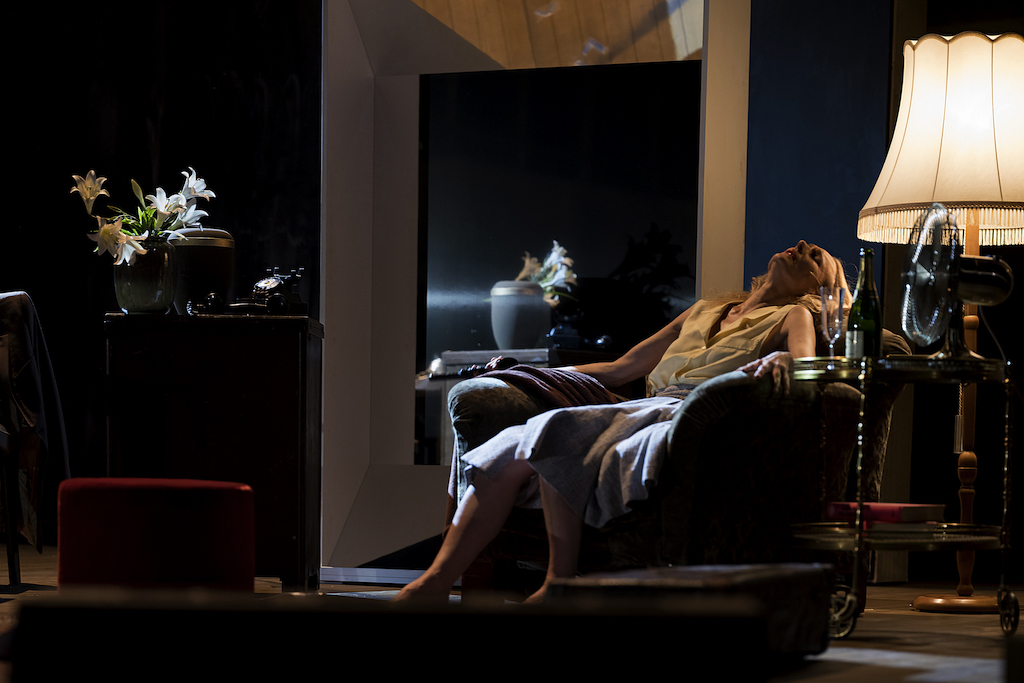Bon Voyage, Bob, Tanztheater Wuppertal Pina Bausch, Sadler's Wells review - interminable ennui | reviews, news & interviews
Bon Voyage, Bob, Tanztheater Wuppertal Pina Bausch, Sadler's Wells review - interminable ennui
Bon Voyage, Bob, Tanztheater Wuppertal Pina Bausch, Sadler's Wells review - interminable ennui
At three and a half wearisome hours, this feels like a marathon

It's a decade since Pina Bausch sadly died, and during that time her company has kept her memory alive by revisiting her amazingly rich legacy. Inevitably, though, the time would come for them to embark on a new phase; but how?
In 2015 the company finally took the plunge and invited two choreographers to create new pieces for them. After premiering in Wuppertal last year, both productions have now come to Sadler’s Wells. Norwegian choreographer Alan Lucien Oyen seems like a perfect choice since he works across genre – with dance, theatre, text and film. A meditation on death and the way we cope with loss, and thereby an indirect acknowledgement of the huge gap left by Bausch’s sudden death, Bon Voyage, Bob has all the right ingredients.
The demise of brothers, fathers, mothers and sisters through accident, illness, murder and suicide are recalled in disjointed snippets. Time has stopped; the hands of the clock are stuck, and the man trying to adjust them is (literally) left hanging off the door frame. Welcome to a world of surreal detachment in which, thanks to Alex Eales’ nimbly revolving set, one visually rich vignette follows another at breakneck speed. One minute we are in a Paris apartment, the next a Turkish hotel, a bedroom, sitting room, church or even a morgue that doubles as a restaurant.
 The cast is kept busy shifting the props and furniture. They build an elaborate set around an armchair in which Julie Shanahan sits, only to dismantle it moments later after she has shot herself (pictured below, photo Meyer Originals); then they roll it all out again for two further repeats. Are we watching a film being made or seeing memories being replayed over and over again? Who knows when the boundaries between fact, fiction, memory and recall are constantly being blurred and the details challenged? In any case, fiction seems far more potent than actuality. Sitting on a bed, Héléna Pikon recalls watching a movie; on screen, she says, “their faces must be 10 metres wide and one teardrop must be gallons of water.” Her tears, by comparison, are so insignificant – nothing.
The cast is kept busy shifting the props and furniture. They build an elaborate set around an armchair in which Julie Shanahan sits, only to dismantle it moments later after she has shot herself (pictured below, photo Meyer Originals); then they roll it all out again for two further repeats. Are we watching a film being made or seeing memories being replayed over and over again? Who knows when the boundaries between fact, fiction, memory and recall are constantly being blurred and the details challenged? In any case, fiction seems far more potent than actuality. Sitting on a bed, Héléna Pikon recalls watching a movie; on screen, she says, “their faces must be 10 metres wide and one teardrop must be gallons of water.” Her tears, by comparison, are so insignificant – nothing.
Behind her, the bedroom mirror is replaced by a picture window that allows her to see into a neighbouring space where a Wim Wenders-style angel (recognisable from his film Wings of Desire) dances with Julie Shanahan (main picture) while her own face is illuminated by the beam from a cinema projector. Atmospheric lighting by Martin Flack lends each scene the dystopian beauty of a David Lynch movie or an Edward Hopper painting. “I feel like a stranger in my own home,” says one protagonist and this sense of alienation is enhanced by Gunnar Innvaer’s clever sound manipulations. Stories are rarely narrated directly but are recounted over the phone, spoken into dictaphones, left as garbled messages, passed on in broken English or written in letters translated from the German.
And there are some gorgeous moments; Julie Shanahan lights one match after another while, behind her, a lothario dances a duet with his alter ego, a sleek brown horse seductively gyrating on two legs. And Nazareth Panadero runs through the space in a flowing pink robe (pictured above right by Mats Bäcker), laughing hysterically as a funeral director asks his client for details about the demise of her father and philosophises on the ubiquity of death: “You have to think positive,” he advises. “We all have to die.”  Why, then, did I spend so much of the first half longing for it to end? It's because one scene franticly follows another without let up, while the dancing – beautifully fluent solos and awkward or combative duets – feels like little more than a series of interludes, a way of buying time while the next tableau vivant is set up.
Why, then, did I spend so much of the first half longing for it to end? It's because one scene franticly follows another without let up, while the dancing – beautifully fluent solos and awkward or combative duets – feels like little more than a series of interludes, a way of buying time while the next tableau vivant is set up.
And this marathon lasts three and a half wearisome hours. The potential is there for a really good piece, but to reveal the glittering kernel buried within, you’d have to shave at least an hour off the endlessly repeating scenes.
rating
Share this article
Add comment
The future of Arts Journalism
You can stop theartsdesk.com closing!
We urgently need financing to survive. Our fundraising drive has thus far raised £49,000 but we need to reach £100,000 or we will be forced to close. Please contribute here: https://gofund.me/c3f6033d
And if you can forward this information to anyone who might assist, we’d be grateful.

Subscribe to theartsdesk.com
Thank you for continuing to read our work on theartsdesk.com. For unlimited access to every article in its entirety, including our archive of more than 15,000 pieces, we're asking for £5 per month or £40 per year. We feel it's a very good deal, and hope you do too.
To take a subscription now simply click here.
And if you're looking for that extra gift for a friend or family member, why not treat them to a theartsdesk.com gift subscription?
more Dance
 'We are bowled over!' Thank you for your messages of love and support
Much-appreciated words of commendation from readers and the cultural community
'We are bowled over!' Thank you for your messages of love and support
Much-appreciated words of commendation from readers and the cultural community
 R:Evolution, English National Ballet, Sadler's Wells review - a vibrant survey of ballet in four acts
ENB set the bar high with this mixed bill, but they meet its challenges thrillingly
R:Evolution, English National Ballet, Sadler's Wells review - a vibrant survey of ballet in four acts
ENB set the bar high with this mixed bill, but they meet its challenges thrillingly
 Like Water for Chocolate, Royal Ballet review - splendid dancing and sets, but there's too much plot
Christopher Wheeldon's version looks great but is too muddling to connect with fully
Like Water for Chocolate, Royal Ballet review - splendid dancing and sets, but there's too much plot
Christopher Wheeldon's version looks great but is too muddling to connect with fully
 iD-Reloaded, Cirque Éloize, Marlowe Theatre, Canterbury review - attitude, energy and invention
A riotous blend of urban dance music, hip hop and contemporary circus
iD-Reloaded, Cirque Éloize, Marlowe Theatre, Canterbury review - attitude, energy and invention
A riotous blend of urban dance music, hip hop and contemporary circus
 How to be a Dancer in 72,000 Easy Lessons, Teaċ Daṁsa review - a riveting account of a life in dance
Michael Keegan-Dolan's unique hybrid of physical theatre and comic monologue
How to be a Dancer in 72,000 Easy Lessons, Teaċ Daṁsa review - a riveting account of a life in dance
Michael Keegan-Dolan's unique hybrid of physical theatre and comic monologue
 A Single Man, Linbury Theatre review - an anatomy of melancholy, with breaks in the clouds
Ed Watson and Jonathan Goddard are extraordinary in Jonathan Watkins' dance theatre adaptation of Isherwood's novel
A Single Man, Linbury Theatre review - an anatomy of melancholy, with breaks in the clouds
Ed Watson and Jonathan Goddard are extraordinary in Jonathan Watkins' dance theatre adaptation of Isherwood's novel
 Peaky Blinders: The Redemption of Thomas Shelby, Rambert, Sadler's Wells review - exciting dancing, if you can see it
Six TV series reduced to 100 minutes' dance time doesn't quite compute
Peaky Blinders: The Redemption of Thomas Shelby, Rambert, Sadler's Wells review - exciting dancing, if you can see it
Six TV series reduced to 100 minutes' dance time doesn't quite compute
 Giselle, National Ballet of Japan review - return of a classic, refreshed and impeccably danced
First visit by Miyako Yoshida's company leaves you wanting more
Giselle, National Ballet of Japan review - return of a classic, refreshed and impeccably danced
First visit by Miyako Yoshida's company leaves you wanting more
 Quadrophenia, Sadler's Wells review - missed opportunity to give new stage life to a Who classic
The brilliant cast need a tighter score and a stronger narrative
Quadrophenia, Sadler's Wells review - missed opportunity to give new stage life to a Who classic
The brilliant cast need a tighter score and a stronger narrative
 The Midnight Bell, Sadler's Wells review - a first reprise for one of Matthew Bourne's most compelling shows to date
The after-hours lives of the sad and lonely are drawn with compassion, originality and skill
The Midnight Bell, Sadler's Wells review - a first reprise for one of Matthew Bourne's most compelling shows to date
The after-hours lives of the sad and lonely are drawn with compassion, originality and skill
 Ballet to Broadway: Wheeldon Works, Royal Ballet review - the impressive range and reach of Christopher Wheeldon's craft
The title says it: as dancemaker, as creative magnet, the man clearly works his socks off
Ballet to Broadway: Wheeldon Works, Royal Ballet review - the impressive range and reach of Christopher Wheeldon's craft
The title says it: as dancemaker, as creative magnet, the man clearly works his socks off
 The Forsythe Programme, English National Ballet review - brains, beauty and bravura
Once again the veteran choreographer and maverick William Forsythe raises ENB's game
The Forsythe Programme, English National Ballet review - brains, beauty and bravura
Once again the veteran choreographer and maverick William Forsythe raises ENB's game

Comments
Totally agree, misuse of
Ouch a glowing review and